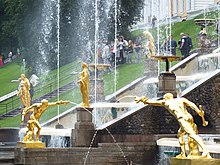Borghese fencer

As Borghese Fencer , even Borghese Gladiator , which is ancient life-size statue of a likely ankämpfenden against a mounted warrior called. The statue was found in the first decade of the 17th century during excavations commissioned by Cardinal Scipione Borghese near Porto d'Anzio - possibly in the remains of a villa of Nero - and is now in the Louvre in Paris . It is about 100 BC. A marble copy of a bronze original from the 3rd century BC. Chr.
The Borghesian fencer was broken into 17 pieces at the time it was found and was restored in 1611 by the sculptor and painter Nicolas Cordier . In 1613 the statue came to the Villa Borghese in Rome . It stood there in a ground floor room named after the fencer, but was sold to Napoleon by Camillo Borghese in 1807 and brought to the Louvre with other works of art.
The artist named in the inscription Agasias from Ephesus , son of Dositheus. The sculpture was incorrectly called a gladiator due to old restorations, but it rather depicts a swordsman, "fencer", with the sword and shield missing from the marble original.
reception
There are two replicas of the Borghesi fencers in the Mirabell Gardens in the city of Salzburg . The inner pair on the Bosquet was created in 1689 by Andreas Götzinger , the outer pair by Michael Bernhard Mandl around 1690 to 1695 . Another pair can be found as a replica in the palace gardens of Schloss Leopoldskron .
The sculpture was one of the most admired and copied works of antiquity in the 18th century. A full-size bronze cast was made for Charles I of England and is now in Windsor Castle , another by Hubert Le Sueur was the centerpiece of Isaac de Cau's parterre in Wilton House , now in Houghton House , Norfolk.
There are also z. B. Refills in Petworth House and in the “green court” in Knole , in the Lützschena Palace Park and in the stairwell of the Goethe extension of the Duchess Anna Amalia Library .
Prince Wilhelm Malte I. zu Putbus commissioned Carl August Mencke around 1820 to deliver two bronze fencing figures based on the Borghese fencer for the gate to the palace gardens.
Since 1848 two replicas of the swordsman have been documented on the guard houses of the courtyard of the Charlottenburg Palace in Berlin , at the time with fig leaves in front of the genitals. When these fell and which artist added swords and shields to the hollow-cast zinc statues is unclear.
In Peterhof Palace in Saint Petersburg , at the foot of the large cascade, there are two gilded bronze statues of the Borghesi fencers, each with a water fountain being hurled from the left arm towards the other.
In the 19th and early 20th centuries, casts of the figure were very popular, but mostly in sizes suitable for living rooms, whereby there are two variants, one is the faithful reproduction of the figure - but often ashamed with a fig leaf in front of the sex - without sword and shield and once their representation is supplemented by these two attributes.
The statue is distinguished by its excellent anatomical development and is often used as a model figure for anatomical studies. In Gottfried Keller's artist novel The Green Heinrich , a chapter is dedicated to the Borghesian fencer. A cast of this figure is shown in the genre painting studio scene by the painter Johann Peter Hasenclever .
Web links
- Object entry for Borghesian fencers in the Arachne archaeological database
Remarks
- ↑ Description on the side of the Louvre (English)
- ↑ Inventory number MR 224 or the current MA 527.
- ↑ Salzburgwiki
- ↑ images on vanderkrogt.net ; residenzstadt-putbus.de .
- ^ Charlottenburg Palace: The portal to the Ehrenhof , accessed on February 25, 2015

